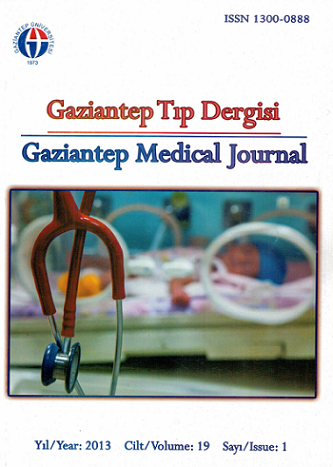Labor induction: comparison between oxytocin and dinoprostone
DOI:
https://doi.org/10.5455/GMJ-30-2012-116Keywords:
Cervical ripening, dinoprostone, labor induction, oxytocinAbstract
Labor induction is one of the most frequent procedures in pregnant women. The optimal regimen for preinduction cervical ripening and labor induction is not established. The aim of the present study was to compare the efficacy and safety of vaginal dinoprostone and intravenous oxytocin administration for labor induction. The medical records of the patients who had induction of labor at Okmeydanı Teaching and Research Hospital, Department of Obstetrics and Gynecology from January 2010 to June 2011 were evaluated retrospectively. The first group (143 patients) received a single dose of sustained- released dinoprostone 10 mg, which was inserted high into the vaginal fornix. The second group (151 patients) received intravenous oxytocin (synpitan). Maternal and fetal outcomes were compared. There were no significant differences between the two groups for parity, birth weight, fetal gender and mode of delivery. 195 (66.3%) of patiens had vaginal delivery and 99 (33.7%) had cesarean delivery. The median time from start of induction of labor to vaginal birth was longer when a prostaglandin E2 was used for labor induction than it was when oxytocin was used (20.1 hours vs 16.1 hours) (p<0.01). No maternal death or uterine rupture occurred. Neonatal weight, admission to neonatal unit, 1 and 5- minute Apgar score <7, did not differ significantly between two groups (p>0.05). Oxytocin is safe, effective and cost-effective treatment. The current study shows that sustained-released Dinoprostone which is an FDA (U.S. Food and Drug Administration) approved drug; is an alternative method for the induction of labor although it is not cost effective.
Metrics
References
Crowley P. Interventions for preventing or improving the outcome of delivery at or beyond term (Cochrane Review). The cochrane library, issue 4. Chichester, UK7 John Wiley & Sons, Ltd; 2003.
Rayburn WF. Prostaglandin E2 gel for cervical ripening and induction of labor: a critical analysis. Am J Obstet Gynecol 1989;160:529-34.
Ulmsten U, Wingerup L, Ekman G. Local application of prostaglandin E2 for cervical ripening or induction of term labor. Clin Obstet Gynecol 1983;26:95-105.
Benrubi GI. Labor induction: historic perspectives. Clin Obstet Gynecol 2000;43:429-32.
Speert H. ed. Obstetrics and gynecology in America: a history. Waverly Press, Baltimore; 1980.
Kelly AJ, Tan B. Intravenous oxytocin alone for cervical ripening and induction of labour. Cochrane Database Syst Rev. 2001;(3): CD003246.
Kadanali S, Küçüközkan T, Zor N, Kumtepe Y. Comparison of labor induction with misoprostol vs. oxytocin/prostaglandin E2 in term pregnancy. Int J Gynecol Obstet 1996;55:99-104.
Buchanan D, Mater J, Yonekura ML. Cervical ripening with prostaglandin E2, vaginal suppositories. Obstet Gynecol 1984;63:659-63.
Mackenzie IZ. Induction of labour at the start of the new millennium. Reproduction 2006;131:989-98.
Sennik BK. Outpatient use of a sustained-release PG E2 vaginal insert: a retrospective study. Today’s Ther Trends 2001;19:77-84.
Yogev Y, Ben-Haroush A, Gilboa Y, Chen R, Kaplan B, Hod M. Induction of labor with vaginal prostaglandin E2. J Matern Fetal Neonatal Med 2003;14:30-4.
Parazzini F, Benedetto C, Danti L, Zanini A, Facchinetti F, Ettore G, et al. A randomized comparison of vaginal prostaglandin E2 with oxytocin plus amniotomy for induction of labour in women with intermediately ripe cervices. Eur J Obstet Gynecol Reprod Biol. 1998;81:15-20.
Andreasson B, Bock JE, Larsen J. Induction of labour. A double-blind randomized controlled study of prostaglandin E2 vaginal suppositories compared with intranasal oxytocin and with sequential treatment. Acta Obstet Gynecol Scand 1985;64:157-61.
Ekman G, Granstrom L, Ulmsten U. Induction of labour with intravenous oxytocin or vaginal PGE2 suppositories. Acta Obstet Gynecol Scand 1986; 65: 857–9.
Legarth J, Lyndrup J, Dahl C, Philipsen T, Eriksen PS. Prostaglandin E2 vaginal suppository for induction of labour: an efficient, safe and popular method. Eur J Obstet Gynecol Reprod Biol 1987;26:233–8.
MacLennan AH, Green RC. The effect of intravaginal prostaglandin F2 alpha on labour after spontaneous and artificial rupture of the membranes. Aust N Z J Obstet Gynaecol 1980;20:87-90.
Macer J, Buchanan D, Yonekura ML. Induction of labour with prostaglandin E2 vaginal suppositories. Obstet Gynecol 1984;63:664–8.
Ramsey PS, Ogburn PL Jr, Harris DY, Heise RH, DiMarco CS, Ramin KD. Effect of vaginal pH on efficacy of the controlledrelease dinoprostone vaginal insert for cervical ripening/ labor induction. J Matern Fetal Neonatal Med 2003;13:250-3.
Ramsey PS, Meyer L, Walkes BA et al. Cardiotocographic abnormalities associated with dinoprostone and misoprostol cervical ripening. Obstet Gynecol 2005;105:85-90.
Kunt C, Kanat-Pektas M, Gungor AN et al. Randomized trial of vaginal prostaglandin E2 versus oxytocin for labor induction in term premature rupture of membranes. Taiwan J Obstet Gynecol 2010;49:57-61.
Silfeler DB, Tandogan B, Ayvaci H, Silfeler I, Yenidede I, Dayicioglu V. A comparison of misoprostol, controlled-release dinoprostone vaginal insert and oxytocin for cervical ripening. Arch Gynecol Obstet 2011;284:1331-7.
Ferguson JE 2nd, Head BH, Frank FH et al. Misoprostol versus low-dose oxytocin for cervical ripening: a prospective, randomized, double-masled trial. Am J Obstet Gynecol 2002;187:273-80.
Bolnick JM, Velazquez MD, Gonzalez JL, Rappaport VJ, Mcllwain-Dunivan G, Rayburn WF. Randomized trial between two active labor management protocols in the presence of an unfavorable cervix. Am J Obstet Gynecol 2004;190:124–28.
Wing DA, Ortiz-Omphroy G, Paul RH. A comparison of intermitent vaginal dministration of misoprostol with continuous dinoprostone for cervical ripening and labor induction. Am J Obstet Gynecol 1997;177:612–18.
Downloads
Published
How to Cite
Issue
Section
License
Copyright (c) 2023 European Journal of Therapeutics

This work is licensed under a Creative Commons Attribution-NonCommercial 4.0 International License.
The content of this journal is licensed under a Creative Commons Attribution-NonCommercial 4.0 International License.


















